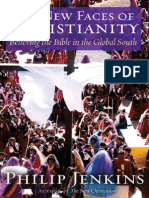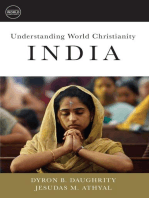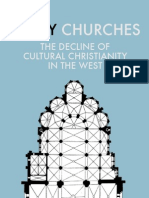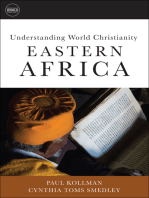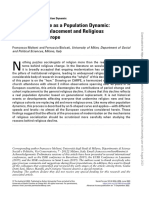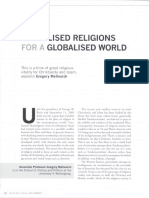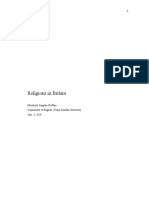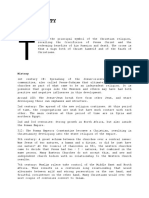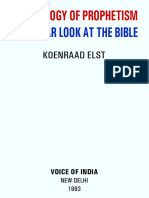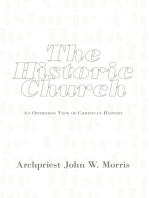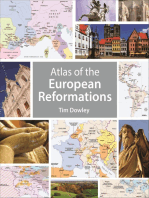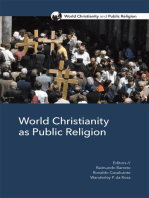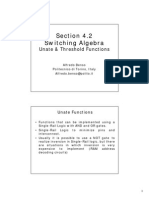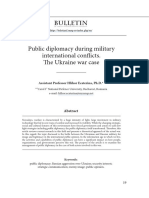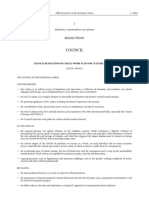Jenkins GodlessEurope
Uploaded by
jamofreyJenkins GodlessEurope
Uploaded by
jamofreyGodless Europe?
Philip Jenkins
hen I tell colleagues that my most recent work is on religion in modern Europe, the inevitable joking reply is, It must be a very short book! Comments of this sort become all the more acute when I say that I am studying the state of contemporary Christianity because, as everyone knows, the faith is dead or dying on the European continent. In the most alarming scenario, a spiritually desolate Europe will inevitably drift toward the faith of its rapidly growing Muslim immigrant communities.1 A provocative slogan warns, Islamour religion today, your religion tomorrow. Bruce Bawer remarks, When Christian faith had departed, it had taken with it a sense of ultimate meaning and purposeand left the continent vulnerable to conquest by people with deeper faith and stronger convictions. It is almost too easy to nd convenient images of the decay of Christianity and of the growth of Islam. Any traveler in modern European cities has noticed the new mosques, the abandoned and secularized churches, some transformed into museums. In the words of former lm star Brigitte Bardot, who these days is a controversial anti-immigration activist, From year to year, we see mosques sprout up pretty much everywhere in France, while church bells are becoming silent because of a lack of priests.2 From the perspective of a North American Christian, Europe might already be a tempting, if difcult, mission eld. Yet although it may be approaching the status of a truth universally acknowledged, the vision of a predominantly Muslim Europe nearby on the historical horizon demands serious qualication. Muslim numbers are far smaller than many might suspect from current jeremiads, while birth rates are plummeting all around the Mediterranean, in Muslim as well as in Christian lands. At the same time, Christianity has not vanished, nor is it approaching extinction, and there are intriguing signs of growth within that secular framework. The recent experience of Christian Europe might suggest not that the continent is potentially a graveyard for religion but rather that it is a laboratory for new forms of faith, new structures of organization and interaction, that can accommodate themselves to a dominant secular environment. Intriguingly, too, some of the most encouraging signs of growth reect the inuences of the global South.
Signs of Collapse
Such a positive portrait might sound surprising when so many indicators point to the decline or collapse of Christian faith. A recent survey for Le Monde des Religions suggested that the number of self-described French Catholics had dropped from 80 percent in the early 1990s to just 51 percent today. As the magazines editor claimed, In its institutions, but also in its mentalities, France is no longer a Catholic country.3 Any number of indices conrm this picture. In terms of religious belief, several different surveys regularly ask people in various nations how important religion is to them. In some Muslim nations, around 90 percent declare that religion plays a
Philip Jenkins, a contributing editor and Distinguished Professor of History and Religious Studies at Pennsylvania State University, University Park, Pennsylvania, is the author of The Next Christendom: The Coming of Global Christianity (Oxford, 2002) and The New Faces of Christianity: Believing the Bible in the Global South (Oxford, 2006).
July 2007
very important role in their lives, while the U.S. gure in 2002 was about 60 percent. The average gure for Europeans was 21 percent, with national variations. The gure for Italy was 27 percent, Germany 21 percent, and France and the Czech Republic 11 percent. Unlike in the United States, moreover, religious disaffection is not expressed merely in nonparticipation in church activities. A signicant number of Europeans declare themselves nonreligious or atheist. A survey of British respondents in 2004 found only 44 percent admitting to belief in God, with 35 percent denying that belief, and 21 percent choosing the answer dont know. Among those aged eighteen through thirty-four, atheist respondents rose to 45 percent.4 European levels of church attendance fall far short of American, and the situation is deteriorating fast. Around 40 percent of Americans report visiting a place of worship weekly, compared with less than 20 percent in most of Europe. According to some estimates, the British attendance gure is 15 percent, with 12 percent in Germany, and Scandinavia below 5 percent. If those gures seem low, then the news for Christians is still more depressing, for the rates include attendance at any place of worship, whether church, mosque, or synagogue. Including Muslim believers produces higher numbers than if we considered Christians only. At the other end of the scale of religious practice are those who never or practically never attend a place of worship. The American gure for seldom or never attending a place of worship is 16 percent. As of 2000, though, such absentees made up 60 percent of French respondents, 55 percent in Britain, and between 40 and 50 percent in Scandinavia and the Low Countries. Young people are much more likely to be never-attenders than regulars. The number of young British people attending Anglican services has halved just since 1979; now only 6 percent of those aged 15 to 29 attend. Between 1900 and 1960, half of those baptized in the Church of England later went on to conrmation; that gure is now 20 percent. In 2005 the English Church Census reported that since 1998 half a million people had stopped going to a Christian church on Sundays.5 Across the Continent, numbers attending Catholic seminaries are often only a tenth of what they were fty or sixty years ago. Such gures have spawned grim forecasts about the Christian future. Former archbishop of Canterbury George Carey has suggested that if the Church of England were a human being, the last rites would be administered at any moment. He sees the church as an elderly lady who mutters away to herself in a corner, ignored most of the time. Cardinal Cormac MurphyOConnor, archbishop of Westminster, has said that Christianity, as a sort of backdrop to peoples lives and moral decisionsand to the government, the social life of the countryhas now almost been vanquished.6 In Germany, similarly, the Evangelical Church, EKD, which includes most Protestants, has lost over half its membership in the past half-century. Though in theory the church claims the loyalty of around a third of the population, some 28 million notional members, only a million or so demonstrate any regular religious participation. Catholic Cardinal Joachim Meisner of Cologne has said, Weve never had as much money as in the last 40 years, and weve never lost the substance of the faith as much as in the last 40 years. . . . In the Cologne archdiocese, there are 2.8 million Catholics, but in the last 30 years weve lost 300,000. For every one baptism, there are three funerals.7 In 1970
115
the proportion of babies born in Switzerland who were baptized was 95 percent; it 2000 it was only 65 percent.
Faith Persisting
While it would be easy to pile up such statistics, the story is rather more complex. First, Europe is a large continent, with many regional variations. The New Europe of the former Soviet bloc includes other areas of continuing Christian strength, notably in Poland. Though the Catholic Church there suffered some decline after the fall of Communism, it has since rebounded. The number studying for the priesthood grew from 4,500 in 1998 to 7,000 in 2005, and great seminaries like Krakows are as packed as those of western Europe were before Vatican II. Regular attendance at religious services is reported by 78 percent of Poles, and around a third attend Catholic services weekly. Polish migrants have helped revive Catholic churches in Britain and other western European nations, as have exiles from other such strongholds of the faith as Slovakia and Croatia. But in western Europe, too, we must distinguish between a decline or collapse of institutional churches and the survival of Christian faith. Far from having vanished, religious belief is still an important force for many old-stock Europeans, though expressed with less public fervor than in the United States. We see many signs of the latent power of faith, of a persistent undercurrent of spirituality, that manifests itself in surprisingly medieval forms of devotion, including pilgrimage and the veneration of saints. Many thousands travel to Naples each year to witness the stigmata claimed by the mysterious Brother Elia. Less controversially, French surveys over the past half-century have repeatedly shown that by far the most esteemed gure in that nation is Abb Pierre (Henry Grous), the Catholic priest whose Emmaus movement has since 1949 helped the homeless and destitute. The popular response to his death in January 2007 suggested that Frances abandonment of Catholicism is not nearly as complete as some suppose.8 If in fact Christianity is becoming extinct, it is odd that Europe today is living in the golden age of pilgrimage, with a proliferation of shrinessome newly cherished in the past few decades, others rediscovered after a hiatus of some centuries. Critics might well question the kind of faith that such pilgrimages demonstrate, and both Protestants and many liberal Catholics are nervous about the theological content of a Marian healing shrine. But if we regard the pilgrimages to Mecca or Varanasi as symbols of the passionate faith of Muslims or Hindus, then we should treat Christian expressions with equal respect. The worlds largest Marian shrine is Guadalupe in Mexico, which attracts 10 million visitors a year, and 6 million annually visit Brazils church Our Lady of Aparecida. But Europe is still home to several thriving centers that draw pilgrims on a near-Latino scale, and over the past half century the numbers have grown substantially. Partly this growth reects greater ease of travel in the modern world, but the demand is also there, sufciently so in fact to make the early twenty-rst century a glorious era for European pilgrimage. Perhaps Catholic believers are seeking here the kind of religious expression that they would previously have found in their parish churches, a sense of mystery and spiritual power that became scarcer after the reforms of the Second Vatican Council. Lourdes, for instance, drew about a million each year in the 1950s, before the council. That number is now closer to 6 million annually, and several thousand might pass through even on a quiet day.9 Just since the late 1980s, pilgrimage has enjoyed a breathtaking revival at Santiago de Compostela, which now
116
attracts some half a million pilgrims in a regular year, rising to a million in special holy years. Shrine-rich Italy draws many pilgrims, though in a place like Rome or Assisi it is difcult to distinguish between pilgrims and tourists. But for whatever reasons, millions each year visit the Holy House of Loreto or the tomb of St. Anthony of Padua. When the Shroud of Turin was exhibited publicly in 2000, all the accumulated scientic doubts about the relics authenticity did not prevent the attendance exceeding a million. Among Orthodox churches, too, the revival of monasticism since the fall of Communism has led to a reestablishment of ancient shrines that once more draw large numbers of pilgrims. Such once great landmarks of Russian Christianity as Sergiev Posad and Valaam are ourishing anew, offering spiritual direction to seekers. So is Optina Pustyn, which in its day welcomed Tolstoy and Dostoevsky.
Signs of Revival: Roman Catholic Church
Such manifestations of latent faith suggest that many Europeans practice what sociologist Grace Davie has termed believing without belonging. And for some believers, the refusal to belong might in its way be a positive or encouraging sign, as it has separated faith from the bureaucratic structures of comprehensive national churches. If in fact a church stands no realistic chance of incorporating all members of a society, then it can become a smaller and more focused body, more rigorously committed to personal holiness and transformation. Pruning can promote growth, and the sharper the pruning, the stronger the growth. In its newly found minority setting, Christianity can restructure itself to serve the needs of a new society, demanding more commitment and involvement in some areas of life while acknowledging greater exibility in others. Perhaps surprisingly, it is within Europes Roman Catholic churches that such a reorientation has been most intensely discussed. These churches, after all, have for centuries maintained very close alliances with states, and they have acted as if all baptized members of a community were sons and daughters of one church, which in practice meant virtually all members of society. Yet however powerful the idealistic vision of an all-embracing Catholic society, some inuential thinkers have recognized that it no longer bears much resemblance to political reality. The present Pope Benedict has asked how one could speak of a Christian society if in a city like Magdeburg, Christians are only eight percent of the total population, including all Christian denominations. Statistical data shows irrefutable tendencies. . . . There is a reduction in the possibility of identication between people and Church. Christians needed to accommodate themselves to the idea of minority status, a staggering idea from the viewpoint of nineteenth- or twentieth-century Catholicism: The Church of the rst three centuries was small, without being, by this fact, a sectarian community. On the contrary, it was not closed in on itself, but felt a great responsibility in regard to the poor, the sickin regard to all.10 Since the 1980s the Vatican has strongly encouraged the development of new religious orders pledged to the defense and expansion of the faith. Among the most successful have been Opus Dei, the Neocatechumenate, the Focolare, and Communion and Liberation; smaller examples include the Community of SantEgidio, LArche, the Schnstatt movement, the Emmanuel Community, and Regnum Christi. In the mid-1980s Pope John PaulII publicly acknowledged the great and promising owering of ecclesial movements, and I have singled them out as a cause for a hope in the entire church and for all mankind. In 1998 he
INTERNATIONAL BULLETIN OF MISSIONARY RESEARCH, Vol. 31, No. 3
welcomed representatives of the orders at a vast convocation that gathered on Pentecost, the day that marks the outpouring of the Spirit upon the church. In Rome in 2006, at another Pentecost, Pope BenedictXVI addressed 300,000 members of the new movements gathered in St. Peters Square.11 Some of these groups trace their origin to the charismatic movement, which grew in parallel with the Pentecostal and charismatic movements within Protestantism. Counting Catholics and Protestants together, the numbers are impressive, especially when we compare them with the Muslim population, which has received so much media attention in recent years. Roughly, Europes evangelicals, charismatics, and Pentecostals outnumber Muslims by almost two to one and will continue to do so for the foreseeable future. Charismatics became a potent force within the Catholic Church during the late 1960s, and in 1975 they received the powerful backing of Pope Paul VI. In the 1970s the movement developed a signicant following in Italy, where the Rinnovamento nello Spirito became an ecclesial movement in its own right. By 2000 the movement claimed 250,000 followers, organized in 1,300 communities and groupings, with at least some presence in every Italian diocese.12 The movement also boomed in France. A French network of charismatic prayer groups spread rapidly as groups grew and then split to form new cells. Soon the network institutionalized in the form of the Emmanuel Community, which was formally recognized by the church in 1992; today it has some 6,000 members, including 130 priests. Like other Catholic charismatics, they distinguish themselves from their Protestant counterparts by their profound veneration for the Virgin Mary and their use of pilgrimage. Since 1975 the community has based itself at Paray-le-Monial, which in the seventeenth century became famous as the site of the rst reported vision of the Sacred Heart of Jesus and which continues today as a pilgrimage site that attracts 300,000 visitors annually. In addition to that total,
Signs of Revival: Other Christian Groups
Outside the Roman Catholic Church, other Christian bodies have also offered imaginative responses to the prospect of Christian decline and minority status. Germany, for instance, now has a substantial revivalist movement that ts poorly with the sober state-oriented traditions of that nations Protestantism. In the 1990s former YMCA director Ulrich Parzany formed the movement ProChrist, which modeled itself on the North American Billy Graham crusades, adapted to the electronic age. (Parzany himself is a Lutheran pastor.) The movement holds revivals at a central ___location, which are then broadcast to a thousand local centers scattered across twenty European nations, so that over a million can participate remotely.15 Most studies place Great Britain (together with the Netherlands) at the leading edge of European secularization, yet it is within the Church of England that pruning has been most effective. Through most of the nineteenth and twentieth centuries, the church was divided between two parties, high and lowthe liturgical Anglo-Catholics and the evangelicals. Since the 1960s, however, the high party has shrunk into virtual insignicance, while evangelicals have ourished. They have in fact come to resemble an enthusiastic U.S. denomination, although often worshiping in venerable Gothic churches.16 The movement is seen at its strongest in a London parish such as Holy Trinity, Brompton (HTB), which attracts over 3,000 to its Sunday services. As in an American megachurch, the life of Holy Trinity is based on intense small-group activities, organized through its fty pastorates, lay-led groups of twenty-ve to thirty each who meet fortnightly in nonchurch locations. Holy Trinity is committed to church planting and has established seven offshoot churches following its evangelical principles and worship style. HTB is also the source of the Alpha Program, which has had a potent inuence beyond British shores. The Catholic archbishop of Paris has described the Alpha course as one of the two greatest gifts of Protestants to Catholics in modern timesthe other being the charismatic movement itselfand hundreds of French churches now sponsor Alpha. Though HTB has acquired worldwide fame, it is by no means the only church of its kind. In Chorleywood in Hertfordshire we nd the charismatic church of St. Andrews, which is also part of the Anglican Church and also offers an impressive range of levels of involvement. Besides full-scale services, the churchs Mid-Size Communities give a fresh and exciting new expression to our life as a church by setting free the creative dynamic of a group of church members that is larger than a small or cell group but considerably smaller than a Sunday service gathering. Some of Britains most ourishing evangelical congregations either are Anglican or involve Anglican alliances with other traditions; other examples include All Souls in Langham Place, Holy Trinity Cheltenham, and St. Thomass Shefeld.17 Anglicans within the church cooperate with evangelicals from other bodies, including the remnants of the old Nonconformist churches that were once so powerful a force in British politics and culture. British Christianity also has its own version of the new ecclesial movements, groups that originated as ad hoc fellowships and networks but that have since acquired an institutional life of their own. Spring Harvest began as a Christian conference in 1979 and has now become a regular event, attracting up to 100,000 enthusiastic believers in several locations around the United Kingdom. Its sponsors claim it as the largest Christian conference in Europe.18 Some movements have grown out of evangelical efforts
117
The revival of monasticism has led to reestablishment of ancient shrines that once more draw large numbers of pilgrims.
some 20,000 attend the summer sessions and retreats organized by the Emmanuel Community for priests, families, and young people. Suggesting the wealth of spiritual sites that survive in contemporary Europe, Paray-le-Monial is near both Taiz and the ancient monastery of Cluny.13 Though little known outside their immediate region, other Catholic communities have produced revival movements, often operating within the charismatic framework. In the Czech Republic, which normally represents a malarial swamp for mainstream spirituality of any kind, Vladimir Mikulica led an inuential charismatic revival that also drew on Orthodox and mystical currents. In neighboring Slovakia, Silvo Krcmry, a Catholic physician who was long persecuted by Communist authorities, subsequently helped turn St. Martins parish, Bratislava, into something like a Catholic megachurch. In the early 1990s members visited Taiz and Paray-le-Monial, which is full of the Holy Spirit, and returned to launch a revival. Members practice street evangelization, and the parishs media operation reaches millions.14
July 2007
within the Church of England, though they have subsequently acquired a more independent identity. One creative gure has been David Pytches, former Anglican bishop of Chile and vicar of St. Andrews, Chorleywood. Pytchess roots are rmly within Anglicanism, with seven generations of family vicars behind me.... I have two brothers ordained and a son-in-law, all clergy. Even so, he drew freely on other Christian traditions. Pytches imported to England the enthusiasm of Latin American charismatic revivalism and was also inuenced by John Wimber, founder of the U.S.-based Vineyard Church. From the late 1980s Pytches became involved in two successful parachurch organizations. One is Soul Survivor, which since 1993 has operated a charismatic Christian version of a rock festival, where young people gather to pray, sing, dance and have fun. New Wine operates training events and summer conferences and has many resemblances to the Vineyard.19
Flourishing Immigrant Churches
Accounts of the collapse of Christianity neglect the growth of immigrant churches among Africans, East Asians, and Latin Americans. Though far less numerous than Muslims, immigrant Christians represent a potent cultural and religious force. Even if we accept the most pessimistic view of the fate of Christianity among Europes old-stock white populations, these thriving new churches represent an exciting new planting, even potentially a kind of reevangelization. Perhaps the most successful example today is the Kiev-based church founded by Nigerian Sunday Adelaja, the Embassy of the Blessed Kingdom of God for All Nations. Sunday Adelaja was one of many bright African and Asian students brought to the Soviet Union to receive an education and ideally to become a future advocate of pro-Soviet views. Within a couple of years the Soviet Union itself dissolved, and in 1994 Adelaja founded a Pentecostal congregation in the new Ukrainian republic. From seven founding members, the church soon claimed 30,000 adherents, overwhelmingly white, and some very powerful indeed. Over twenty services are held every Sunday in various auditoriums of
Accounts of the collapse of Christianity neglect the growth of immigrant churches.
Kiev, Ukraine. Over fty daughter churches function in the Kiev region. More than a hundred daughter and satellite churches exist in the cities and villages of Ukraine. Over two hundred churches in the countries of the former Soviet Union, the USA, Germany, UAE, Israel, and Holland have been founded.... The churchs Christian television and radio programs reach approximately eight million people.20 Sunday Adelaja is only one of many successful Third World evangelists now operating in Europe, though he stands out in his ability to attract white Europeans. Some transnational Christian networks operate in literally dozens of nations, churches headquartered in one of the great missionary nations of the modern world, such as Brazil, Nigeria, DR Congo, the Philippines, or South Korea. Particularly important are the African-Initiated Churches (AICs), bodies of African foundation and worship style.
118
During the 1960s London became the base for several Aladura churches, including the Celestial Church of Christ, Church of the Lord Aladura, the Cherubim and Seraphim, and Christ Apostolic Church. The Aladura tradition is powerfully represented by the Redeemed Christian Church of God (RCCG), founded in Nigeria in 1952, which has a strong missionary outreach. At the last count, there are at least about four thousand parishes of the Redeemed Christian Church of God in Nigeria.... In Europe the church is spread in England, Germany, and France. In addition to its African presence, the Congolese Kimbanguist church, lglise de Jsus Christ sur la Terre par son Envoy Spcial Simon Kimbangu, is active in Spain, Portugal, France, Germany, Belgium, Switzerland, and England. Brazilian congregations, such as the Universal Church of the Kingdom of God, are widespread. So are Philippine lay charismatic communities like the astonishing El Shaddai, which operates in some thirty countries, or the Brazilian Igreja Universal do Reino de Deus, or IURD, the aptly titled Universal Church of the Kingdom of God.21 Some churches of global South origin have ourished. One example is Londons Jesus House, established in 1994 as a new planting by the RCCG. Today it claims over 2,000 weekly participants, and numbers are growing steadily. Of Britains ten largest megachurches, fourGlory House, Jesus House, Kingsway International Christian Centre, and New Wine Ministriesare pastored by Africans. This is not solely a British phenomenon, nor are large works arising only from Nigeria, for the Congolese have rivaled the Nigerians in their church-building zeal. By 2003 one of Europes largest Congolese churches was the Belgiumbased New Jerusalem, with 1,300 members, and 900 attend Sunday worship at Pariss Assemble des Fidles aux Prires Chrtiennes. France today has a series of ethnic church federations representing, for instance, the Madagascarian and Haitian communities. The Congolese-initiated Communaut des glises dExpressions Africaines de France (CEAF) claims thirty-ve congregations across France.22 Greater Paris has 250 ethnic Protestant churches, chiey black African. Immigrants are concentrated especially in the 93, the postal code of the department of Seine St. Denis. Sixty evangelical churches operate in the 93, including a dozen afliated with the CEAF, with names like Good Seed and Gethsemane. The RCCG has a presence in Seine St. Denis, where we also nd a Laotian church and a Portuguese congregation of the Assemblies of God. Other host nations have their new Christian stories. Germany has at least 1,100 foreign-language Protestant churches, with some 80,000 members. The rst AIC appeared in 1974, when the Nigerian Celestial Church of Christ (an Aladura foundation) opened in Munich. By the end of the century, two hundred AICs were recorded: forty in Hamburg, twenty each in Berlin and Frankfurt, perhaps a hundred in the Rhine-Ruhr valley. Germany has its Aladura churches and its Kimbanguists. While African missionaries established some congregations, many grew out of local fellowships and Bible study groups on German soil, such as the All Christian Believers Fellowship, founded in Karlsruhe in 1993.23 In some cases (globalization in action!) Africans in Germany formed their own churches, which then set up branches in the mother countries in Africa itself. In Hamburg in 1992 Ghanaian Abraham Bediako founded the Christian Church Outreach Mission, which seems on the way to becoming a denomination in its own right. It has a dozen churches in Germany and more than sixty in Ghana itself. The church describes itself as an international, non-denominational multi-racial church and a full-gospel, charismatic faith congregation with branches in Germany, Holland, Great Britain, Spain, United States and Ghana.24
INTERNATIONAL BULLETIN OF MISSIONARY RESEARCH, Vol. 31, No. 3
In short, European Christianity is neither dead nor dying. We have powerful evidence of latent faith, however remote that may be from actual church membership. We see effervescent new movements within the churches, and then there are the genuinely exciting immigrant communities. Furthermore, recent conicts with Islamic extremism have forced mainstream secular-minded Europeans to ask just what their values are based on, and in many cases they are forced to reconsider the claims of Christianity. In a series of recent essays that have astonished his admirers, venerated leftist philosopher Jrgen Habermas proclaims that
Christianity, and nothing else, is the ultimate foundation of liberty, conscience, human rights, and democracy, the benchmarks of Western civilization. To this day, we have no other options [to Christianity]. We continue to nourish ourselves from this source. Everything else is postmodern chatter.25 As German bishop Jobst Schne has observed, Perhaps God is using the Muslims to bang our Christian heads together.26 So I have to answer my jokesters in the negative: my book on Europes religion is anything but short. And European Christianity is not an oxymoron.
1. Philip Jenkins, Gods Continent: Christianity, Islam, and Europes Religious Crisis (New York: Oxford Univ. Press, 2007). 2. Bruce Bawer, While Europe Slept (New York: Doubleday, 2006), p. 34. Bardot is quoted from Joel S. Fetzer and J. Christopher Soper, Muslims and the State in Britain, France, and Germany (Cambridge: Cambridge Univ. Press, 2005), p. 130. 3. Henry Samuel, France No Longer a Catholic Country, Daily Telegraph, January 10, 2007. 4. Among Wealthy Nations, U.S. Stands Alone in Its Embrace of Religion, Pew Global Attitudes Survey (Washington, D.C.: Pew Research Center, 2002), http://pewglobal.org/reports/pdf/167.pdf. The 2004 British survey is taken from the YouGov/Daily Telegraph Survey, at www.yougov.com/archives/pdf/STI040101003_2.pdf. For nonreligious responses in France, see Brigitte Marchal, Stefano Allievi, Felice Dassetto, and Jrgen Nielsen, eds., Muslims in the Enlarged Europe (Leiden: Brill, 2003). 5. Wil Arts and Loek Halman, eds., European Values at the Turn of the Millennium (Leiden: Brill, 2004); and Loek Halman, Ruud Luijkx, and Marga van Zundert, eds., Atlas of European Values (Leiden: Tilburg Univ., 2005), with additional data at www.gesis.org/za; Christie Davies, The Strange Death of Moral Britain (New Brunswick, N.J.: Transaction, 2004). For recent British gures, see Ruth Gledhill, Church Seeks Spirituality of Youth ... and Doesnt Like What It Finds, Times (London), May 8, 2006. British conrmation gures are from Niall Ferguson, Heaven Knows How Well Rekindle Our Religion, but I Believe We Must, Daily Telegraph, July 31, 2005. For the English Church Census, see Jonathan Petre, Migrants Fill Empty Pews As Britons Lose Faith, Daily Telegraph, September 18, 2006. 6. Carey is quoted from Kate Fox, Watching the English (London: Hodder & Stoughton, 2004), p.354. For Murphy-OConnor, see Gill Donovan, Cardinal Says Christianity Is Almost Vanquished, National Catholic Reporter, September 14, 2001. 7. Meisner is quoted at John L. Allen, Jr., The Word from Rome, National Catholic Reporter, March 17, 2006. 8. Abbe Pierre: Campaigner for the Homeless Who Was Regularly Named As the Most Admired Man in France, Independent, January 23, 2007; Abb Pierre, Economist, February 1, 2007. 9. Mary Lee Nolan and Sidney Nolan, Christian Pilgrimage in Modern Western Europe (Chapel Hill: Univ. of North Carolina Press, 1989); Victor Turner and Edith Turner, Image and Pilgrimage in Christian Culture (New York: Columbia Univ. Press, 1978), pp. 20330. 10. Joseph Ratzinger, Above All, We Should Be Missionaries (2000), http://tcrnews2.com/genratzinger.html; John L. Allen, Jr., The Rise of Benedict XVI (New York: Doubleday, 2005). For a Protestant perspective, compare Jonathan Bartley, Faith and Politics After Christendom (London: Authentic Media, 2006). 11. The great and promising owering is from Gordon Urquhart, The Popes Armada (London: Bantam, 1995), p. 5; Tony Hanna, New Ecclesial Movements (London: St. Pauls, 2006). All the movements have a lively presence on the Web. See, for instance, www.schoenstatt. de/ and www.regnumchristi.org/; Communion and Liberation can be found at www.clonline.org/; the Community of SantEgidio at www.santegidio.org/en/index.html. 12. www.rns-italia.it/default2.htm; Bishop Paul Josef Cordes, Charisms
120
Notes
and New Evangelization (New York: Hyperion Books, 1996); Bishop Paul Josef Cordes, Call to Holiness (Collegeville, Minn.: Michael Glazier Books, 1997); Peter Zimmerling, Die Charismatischen Bewegungen (Gttingen: Vandenhoeck & Ruprecht, 2001). 13. www.emmanuelcommunity.com. 14. www.cho.cz/www/index.php; www.martindom.sk/. 15. Jan-Peter Graap, Doubt and Amazement: ProChrist2006 in Europe, at www.lausanneworldpulse.com/worldreports/320/05-2006. 16. Andrew Chandler, The Church of England in the Twentieth Century (Woodbridge, Eng.: Boydell Press, 2006). 17. For Holy Trinity Brompton, see www.htb.org.uk; the account of Mid-Size Communities is from www.st-andrews.org.uk/mid-sizecommunities.php. 18. www.springharvest.org/; David W. Bebbington, Evangelicalism in Modern Britain (London: Routledge, 1988); William K. Kay, Pentecostals in Britain (Carlisle, Eng.: Paternoster Press, 2000). 19. David Pytches, Living at the Edge (Bath: Arcadia, 2002); www. soulsurvivor.com/; www.new-wine.org/. 20. www.godembassy.org/en/embassy.php. 21. Les glises Africaines se dveloppent en Europe, Religioscope, January 19, 2003, www.religioscope.info/article_41.shtml; Gerrie ter Haar, African Christians in Europe (Nairobi: Acton, 2001); Gerrie ter Haar, African Christians or Christian Africans in Europe? in Uniquely African? ed. James L. Cox and Gerrie ter Haar (Trenton, N.J.: Africa World Press, 2003); Khalid Koser, ed., New African Diasporas (New York: Routledge, 2003). For El Shaddai, see Kartharine L. Wiegele, Investing in Miracles (Honolulu: Hawaii Univ. Press, 2004). Web sites of the individual churches can be found at www.rccg.org/ and www.igrejauniversal.org.br/. 22. For the Congolese diaspora in Europe, see Clestin Kibutu Ngimbi, Comment devient-on pasteur en Rpublique Dmocratique du Congo? www.congovision.com/science/marasme21.html; Marc Spindler, glises trangres en Europe, at www.protestants. org/textes/protestantisme_europe/acteurs_spindler.htm; Bernard Coyault, Christianisme: Radioscopie des glises dExpression Africaine en France, at http://www.voxdei.org/afcher_info. php?id=12897.68. For the Communaut des glises dExpressions Africaines de France, see www.eglises.org/types/ceaf/. 23. Benjamin Simon, Christian Pluralism and the Quest for Identity in African Initiated Churches in Germany, www.cesnur.org/2001/ london2001/simon.htm. See also Gerrie ter Haar, African Christians in the Netherlands, in Strangers and Sojourners, ed. Gerrie ter Haar (Louvain: Peeters Publishers, 1998), pp. 15372; J. A. B. Jongeneel, R. Budiman, and J. J. Visser, Gemeenschapsvorming van Aziatische, Afrikaanse en Midden-en Zuidamerikaanse Christenen in Nederland (Zoetermeer: Boekencentrum, 1996). 24. For the Christian Church Outreach Mission, see Les glises Africaines se dveloppent en Europe. See also www.ccomi.org/pastors. html. 25. Sandro Magister, The Church Is Under Siege, at www.chiesa. espressonline.it/dettaglio.jsp?id=20037&eng=y; Jrgen Habermas, Time of Transitions (New York: Polity Press, 2006). 26. Jobst Schne as quoted by Uwe Siemen-Netto, Faith: Islams Third Run for Europe (2002), www.islamawareness.net/Fastest/third. html.
INTERNATIONAL BULLETIN OF MISSIONARY RESEARCH, Vol. 31, No. 3
You might also like
- Pub - The Next Christendom The Coming of Global Christia PDF100% (13)Pub - The Next Christendom The Coming of Global Christia PDF288 pages
- The Celtic Way of Evangelism, Tenth Anniversary Edition: How Christianity Can Reach the West . . .AgainFrom EverandThe Celtic Way of Evangelism, Tenth Anniversary Edition: How Christianity Can Reach the West . . .Again4/5 (53)
- Davie - Believing Without Belonging-Is This The Future of Religion in Britain100% (2)Davie - Believing Without Belonging-Is This The Future of Religion in Britain15 pages
- Lamont The Jesuit Vatican New World OrderNo ratings yetLamont The Jesuit Vatican New World Order16 pages
- What Is Happening To Global ChristianityNo ratings yetWhat Is Happening To Global Christianity8 pages
- God is an Englishman: Christianity and the Creation of EnglandFrom EverandGod is an Englishman: Christianity and the Creation of EnglandNo ratings yet
- Why Nations Are Becoming More Secular PDFNo ratings yetWhy Nations Are Becoming More Secular PDF6 pages
- Where Are the Poor?: A Comparison of the Ecclesial Base Communities and Pentecostalism—A Case Study in Cuernavaca, MexicoFrom EverandWhere Are the Poor?: A Comparison of the Ecclesial Base Communities and Pentecostalism—A Case Study in Cuernavaca, MexicoNo ratings yet
- To Whom Does Christianity Belong?: Critical Issues in World ChristianityFrom EverandTo Whom Does Christianity Belong?: Critical Issues in World ChristianityNo ratings yet
- The Death of Western Christianity: Drinking from the Poisoned Wells of the Cultural RevolutionFrom EverandThe Death of Western Christianity: Drinking from the Poisoned Wells of the Cultural RevolutionNo ratings yet
- Grace Davie - Is Europe An Exceptional CaseNo ratings yetGrace Davie - Is Europe An Exceptional Case12 pages
- Word, Words and Worship: Revelation, Truth, Authority and Worship in Late-Modern and Pluralistic EuropeNo ratings yetWord, Words and Worship: Revelation, Truth, Authority and Worship in Late-Modern and Pluralistic Europe24 pages
- Presentation Rafael Palomino (Sin Vínculos Notas)No ratings yetPresentation Rafael Palomino (Sin Vínculos Notas)6 pages
- Molteni y Biolcati - Religious Decline As A Population DynamicNo ratings yetMolteni y Biolcati - Religious Decline As A Population Dynamic25 pages
- Reformation Myths: Five Centuries Of Misconceptions And (Some) MisfortunesFrom EverandReformation Myths: Five Centuries Of Misconceptions And (Some) Misfortunes3/5 (2)
- The End of Secularization in Europe?: A Socio-Demographic PerspectiveNo ratings yetThe End of Secularization in Europe?: A Socio-Demographic Perspective23 pages
- Practicing Christians, Practical Atheists: How Cultural Liturgies and Everyday Social Practices Shape the Christian LifeFrom EverandPracticing Christians, Practical Atheists: How Cultural Liturgies and Everyday Social Practices Shape the Christian LifeNo ratings yet
- Youth Engagement With Religion and Faith in the 21st Century.No ratings yetYouth Engagement With Religion and Faith in the 21st Century.16 pages
- joppke-2018-culturalizing-religion-in-western-europe-patterns-and-puzzlesNo ratings yetjoppke-2018-culturalizing-religion-in-western-europe-patterns-and-puzzles13 pages
- Missherly Angelia 61418011 - British FENo ratings yetMissherly Angelia 61418011 - British FE11 pages
- Church Planting in the Secular West: Learning from the European ExperienceFrom EverandChurch Planting in the Secular West: Learning from the European ExperienceNo ratings yet
- The Triumph of Christianity: How the Jesus Movement Became the World's Largest ReligionFrom EverandThe Triumph of Christianity: How the Jesus Movement Became the World's Largest ReligionNo ratings yet
- Christianity_2018_More_African_ChristianNo ratings yetChristianity_2018_More_African_Christian9 pages
- Evangelism in a Post Christian Culture: Teach Yourself to Share the GospelFrom EverandEvangelism in a Post Christian Culture: Teach Yourself to Share the GospelNo ratings yet
- Psychology of Prophetism A Secular Look at The Bible Book by KoenraadNo ratings yetPsychology of Prophetism A Secular Look at The Bible Book by Koenraad177 pages
- THEOLOGY 3 NOTES & REVIEWER (Finals 1st Sem)No ratings yetTHEOLOGY 3 NOTES & REVIEWER (Finals 1st Sem)18 pages
- THEOLOGY 3 NOTES & REVIEWER (Finals 1st Sem)No ratings yetTHEOLOGY 3 NOTES & REVIEWER (Finals 1st Sem)6 pages
- The Historic Church: An Orthodox View of Christian HistoryFrom EverandThe Historic Church: An Orthodox View of Christian HistoryNo ratings yet
- Giving Up On God: The Global Decline of ReligionNo ratings yetGiving Up On God: The Global Decline of Religion16 pages
- "Christianity": Christianity Is The Religion That Follows The Teachings of JesusNo ratings yet"Christianity": Christianity Is The Religion That Follows The Teachings of Jesus4 pages
- Papal Teaching in the Age of Infallibility, 1870 to the Present: A Critical Evaluation with Historical IllustrationsFrom EverandPapal Teaching in the Age of Infallibility, 1870 to the Present: A Critical Evaluation with Historical IllustrationsNo ratings yet
- Keeping Alive the Rumor of God: When Most People Are Looking the Other WayFrom EverandKeeping Alive the Rumor of God: When Most People Are Looking the Other WayNo ratings yet
- The After-Life of Inka Rulers: Andean Death Before and After Spanish ColonizationNo ratings yetThe After-Life of Inka Rulers: Andean Death Before and After Spanish Colonization28 pages
- Harder - Numerical Analysis For EngineeringNo ratings yetHarder - Numerical Analysis For Engineering5 pages
- Drones in Hybrid Warfare: Lessons From Current Battlefields: Hybrid Coe Working Paper 10100% (2)Drones in Hybrid Warfare: Lessons From Current Battlefields: Hybrid Coe Working Paper 1032 pages
- Instant Download The Political Economy of Independent Ukraine: Slow Starts, False Starts, and a Last Chance? 1st Edition Oleh Havrylyshyn (Auth.) PDF All Chapters100% (1)Instant Download The Political Economy of Independent Ukraine: Slow Starts, False Starts, and a Last Chance? 1st Edition Oleh Havrylyshyn (Auth.) PDF All Chapters55 pages
- FFTT "Tree Rings": The 10 Most Interesting Things: We 'Ve Read RecentlyNo ratings yetFFTT "Tree Rings": The 10 Most Interesting Things: We 'Ve Read Recently19 pages
- English Language Newspapers and Magazines in UkraineNo ratings yetEnglish Language Newspapers and Magazines in Ukraine11 pages
- Instructor Manual For Financial & Managerial Accounting 16th (Sixteenth) Edition by Jan R. Williams, Sue F. Haka, Mark S. Bettner, Joseph V. Carcello instant download100% (3)Instructor Manual For Financial & Managerial Accounting 16th (Sixteenth) Edition by Jan R. Williams, Sue F. Haka, Mark S. Bettner, Joseph V. Carcello instant download43 pages
- Instant download (Ebook) Ivan Mazepa and the Russian Empire by Tatiana Tairova-Yakovleva ISBN 9780228003083, 0228003083 pdf all chapter100% (4)Instant download (Ebook) Ivan Mazepa and the Russian Empire by Tatiana Tairova-Yakovleva ISBN 9780228003083, 0228003083 pdf all chapter71 pages
- Projects in Engineering and Machinary UkraineNo ratings yetProjects in Engineering and Machinary Ukraine20 pages
- Pivot, Hedger, or Partner_Strategies of Lesser Powers Caught between HegemonsNo ratings yetPivot, Hedger, or Partner_Strategies of Lesser Powers Caught between Hegemons24 pages
- Unit 14.: 1. Write About A History and Culture of One of The Tourist Destinations (OfNo ratings yetUnit 14.: 1. Write About A History and Culture of One of The Tourist Destinations (Of5 pages
- (English) A Brief History of Ukraine (And Why Russia Wants To Control It) (DownSub - Com)No ratings yet(English) A Brief History of Ukraine (And Why Russia Wants To Control It) (DownSub - Com)18 pages
- Russian Ground Forces Posture Towards The West: Research PaperNo ratings yetRussian Ground Forces Posture Towards The West: Research Paper18 pages
- Crimea and The Russian-Ukrainian Conflict: Anton BeblerNo ratings yetCrimea and The Russian-Ukrainian Conflict: Anton Bebler20 pages
- What Does Glasnost and Perestroika PromiseNo ratings yetWhat Does Glasnost and Perestroika Promise12 pages
- EU Work Plan For Culture (2023-2026) - Council Resolution On The EU Work Plan For Culture 2023-2026 2022No ratings yetEU Work Plan For Culture (2023-2026) - Council Resolution On The EU Work Plan For Culture 2023-2026 202218 pages


